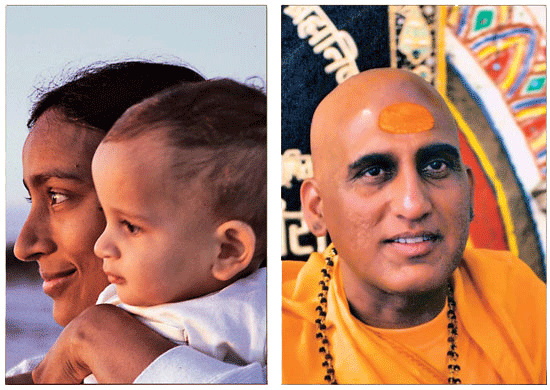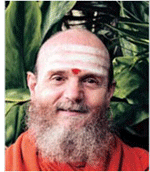
C H A P T E R 10§
Family Life and Monastic Life
The Spiritual Ideals of Hinduism’s Two Noble Paths of Dharma
Exemplars of dharma’s two paths: writer and homemaker Vatsala Sperling of Vermont, USA, with her son Mahar; respected leader of Juna Akhara, Acharya Avdheshananda Ji§
 N HINDUISM THERE HAS ALWAYS been a choice of paths to follow—grihastha or sannyasa, family or monk. Unfortunately, in modern Hinduism the distinction between the two has become muddled, both in the minds of Hindus themselves as well as in textbooks and other writings that present Hinduism to the non-Hindu world. ¶Hinduism’s purusharthas, four goals of life, are a useful reference for understanding the distinction between the two paths. The four goals are 1) dharma, or piety; 2) artha, or wealth; 3) kama, or pleasure; and 4) moksha, or liberation. Those on the grihastha path pursue all four goals, and the way they do so changes according to their age or ashrama in life. Those on the sannyasa path renounce artha, kama and family dharma in one-pointed pursuit of moksha—liberation from rebirth on Earth through intense personal experience of God. ¶For the grihastha, in the first ashrama, brahmacharya, age 12-24, the primary focus is on studying at school and preparing for profession and married life. In the second ashrama, grihastha, age 24-48, the primary focus is raising a family and fulfilling a career. The third ashrama, vanaprastha, age 48-72, is a time of transition from family and career to one of elder advisor to the younger generation. The fourth ashrama, sannyasa, age 72 onward, is a time in which the primary focus is on moksha, meaning that religious practices are the main activity of one’s day. The sannyasin directly enters the fourth ashrama at the time of his initiation, no matter what his age, skipping over the other phases of life. ¶One of the most common ways the two paths have been muddled in modern Hinduism is in the classic textbook notion that Hindus believe the world is unreal and that this is why there is so much poverty in India. This, of course, is an incorrect perception. The accurate statement is that those on the path of the monk are trained to look at the world as impermanent, or unreal or fleeting. Grihasthas, however are not. They pursue the same ideals of success, family and wealth as do families in Western society. ¶Many thoughtful Hindu lay leaders lament the lack of trained Hindus who can speak out in a knowledgeable way about Hinduism. One trend is to train Hindu priests for this capacity, which in the Western world is called a minister. Said another way, Hinduism needs more ministers to TEACH and counsel. Of course, this is one of the roles that Hindu monks traditionally fulfill. Thus, another solution is to produce and train more swamis and sadhus to serve as competent ministers. ¶This 16-page Educational Insight is drawn primarily from Gurudeva’s Master Course trilogy (www.gurudeva.org/resources/books/).§
N HINDUISM THERE HAS ALWAYS been a choice of paths to follow—grihastha or sannyasa, family or monk. Unfortunately, in modern Hinduism the distinction between the two has become muddled, both in the minds of Hindus themselves as well as in textbooks and other writings that present Hinduism to the non-Hindu world. ¶Hinduism’s purusharthas, four goals of life, are a useful reference for understanding the distinction between the two paths. The four goals are 1) dharma, or piety; 2) artha, or wealth; 3) kama, or pleasure; and 4) moksha, or liberation. Those on the grihastha path pursue all four goals, and the way they do so changes according to their age or ashrama in life. Those on the sannyasa path renounce artha, kama and family dharma in one-pointed pursuit of moksha—liberation from rebirth on Earth through intense personal experience of God. ¶For the grihastha, in the first ashrama, brahmacharya, age 12-24, the primary focus is on studying at school and preparing for profession and married life. In the second ashrama, grihastha, age 24-48, the primary focus is raising a family and fulfilling a career. The third ashrama, vanaprastha, age 48-72, is a time of transition from family and career to one of elder advisor to the younger generation. The fourth ashrama, sannyasa, age 72 onward, is a time in which the primary focus is on moksha, meaning that religious practices are the main activity of one’s day. The sannyasin directly enters the fourth ashrama at the time of his initiation, no matter what his age, skipping over the other phases of life. ¶One of the most common ways the two paths have been muddled in modern Hinduism is in the classic textbook notion that Hindus believe the world is unreal and that this is why there is so much poverty in India. This, of course, is an incorrect perception. The accurate statement is that those on the path of the monk are trained to look at the world as impermanent, or unreal or fleeting. Grihasthas, however are not. They pursue the same ideals of success, family and wealth as do families in Western society. ¶Many thoughtful Hindu lay leaders lament the lack of trained Hindus who can speak out in a knowledgeable way about Hinduism. One trend is to train Hindu priests for this capacity, which in the Western world is called a minister. Said another way, Hinduism needs more ministers to TEACH and counsel. Of course, this is one of the roles that Hindu monks traditionally fulfill. Thus, another solution is to produce and train more swamis and sadhus to serve as competent ministers. ¶This 16-page Educational Insight is drawn primarily from Gurudeva’s Master Course trilogy (www.gurudeva.org/resources/books/).§


